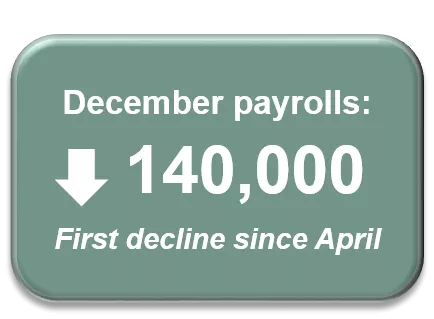January Economic Commentary: Fragile Recovery Leaning on Stimulus, COVID Vaccine

Chief Economist
Pohlad Companies
Last month’s commentary stated that the development of highly effective vaccines was providing a light at the end of the COVID tunnel, but that until inoculations reach sufficient magnitude, challenges will persist and economic data will likely look worse in the near term before the tide fully turns. The strong resurgence of the virus and the re-imposition of lockdowns in various states this winter is clearly validating that concern. The bifurcation of the economy between the haves and the have-nots has become more visible again as the resurgence is negatively impacting the nascent recovery in fragile sectors such as leisure and hospitality.
The most recent report on retail sales indicates that slowing in activity started in October, coincident with the expiration of many Federal stimulus programs and the associated slowing of personal income. While official data is only through November, recent high-frequency data suggest we will see further weakness in upcoming December reports.

Employment and Unemployment
December’s employment report showed a decline of 140,000 jobs—the first decline in non-farm payrolls since April. The weakness is not expected to persist, however, as it was primarily in leisure and hospitality businesses. Improvement in these sectors is anticipated as the economy re-opens over the coming months. On the other side of the coin, professional and business services, manufacturing, retail, construction, transportation, and warehousing all reported increased payrolls.
The unemployment rate was unchanged at 6.7%. The participation rate is 61.5%, down from 63.3% in February. If the participation rate had stayed at the February level of 63.3%, the unemployment rate would be 9.4%. The decline in the participation rate is making the unemployment rate look better than it really is and suggests that there is a large pool of potential workers who may re-enter the work force as the recovery progresses. This large pool of potential workers may make future improvement in the unemployment rate harder to come by while keeping a lid on longer term inflationary pressures.
Manufacturing
Confirming strength in the manufacturing sector, the ISM manufacturing survey reported its best reading since August 2018, with new orders the strongest since 2004. This strength reflects the rebuilding of inventories that have been drawn down. Tight inventories and supply disruptions will likely lead to some upside pricing pressures during the coming year.
Economic Stimulus
In response to the deterioration in economic data, Congress passed a stimulus package of $900 billion on December 20. Expectations are for the new administration to pass additional stimulus in the coming months. The fixed income markets have reflected the likelihood of further stimulus by pricing the 10-year Treasury yield above 1% for the first time since March—a response to expectations of higher inflation and perhaps some concern over the magnitude of the growing U.S. debt.
The Fed has reiterated its intent to keep the Fed Funds rate near zero through 2023, saying that they will keep Fed Funds where they are until “substantial further progress has been made toward the maximum employment and price stability goals.” With short rates anchored by the Fed and longer-term yields rising, we are seeing a steepening of the yield curve—a welcome development for banks.
Looking Forward
Due to the loss of momentum in the economy heading into the new year, the first quarter of 2021 is expected to show the slowest growth for the year with economic activity picking up in the second quarter as the vaccine is more broadly rolled out. Continued economic improvement is forecast through the second half of 2021.
The next few months are likely to remain challenging in terms of economic data until the impact of additional fiscal support and broader vaccine inoculations enable the economy to more fully re-open. Equity markets have already looked beyond the near-term, however, and foresee a stronger economy starting in the second half of 2021—but as always, the path of the virus will be a primary determinant of the strength of the economy.
Insights
Research to help you make knowledgeable investment decisions